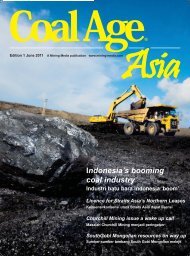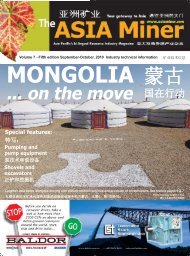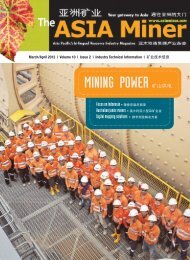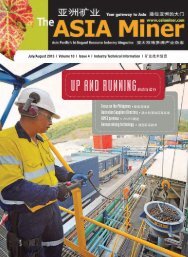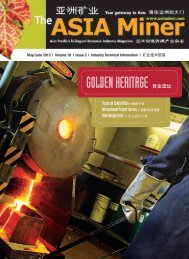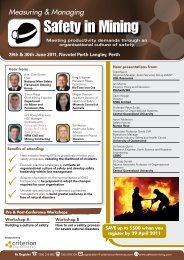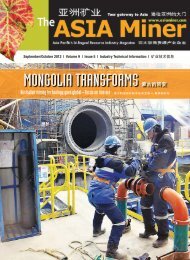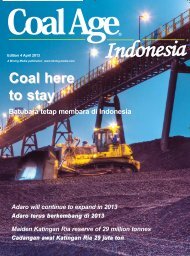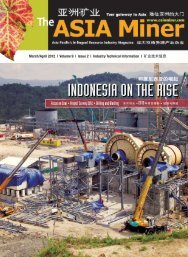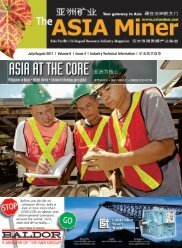Slurry Pumpsis designed to accommodate most mechanicalseals by removing the split stuffing box. “Ifminers want to convert from packing to mechanicalseals, they can remove the split boxand replace it with a mechanical seal withoutmajor modifications,” Morris said. “It is alsoset up with multiple flush ports.”<strong>The</strong> i-Alert conditional monitoring systemidentifies problems early. It measures vibrationand temperature. “Similar to a Check Engineindicator light on a vehicle, it’ s greenwhen operating normally,” Morris said. “Whenoperations deviate from the baseline, it startsto blink red. You can see that light in the milland when it’ s blinking technicians knowsomething is wrong. On one of the tests r e-cently, the light turned red, and when they investigated,they discover ed one of thepull-down bolts on the pedestal was loose.<strong>The</strong>y tightened it and it turned to green.”One of the major safety features is the multiplelift points. “Pumps are not always in a topdischargeposition, so we placed lift pointsaround the casing so you can lift it no matterthe position,” Morris said. “Another gr eatsafety feature is the double-wall design, whichis good to 250 psi (17 bar working pr essure).If a breach occurs, the casing shell pr otectsworkers and the surrounding equipment. Wehave also designed in an optional pressure reliefdevice [burst disc]. It pr events over pressurizationif the pump gets sanded in. Whenthe suction or discharge side is blocked withslurry, the steam generated as the pump heatsup could cause an explosion. Once the temperatureinside the pump exceeds a certainlevel, the device releases the pressure.”ITT Gould’s New XHD Slurry PumpITT Corp. recently launched the new GouldsXHD, an extra heavy-duty, lined slurry pump.<strong>The</strong> company bills it as a next-generationproduct that can handle the heaviest slurryunder the toughest conditions. <strong>The</strong> new XHDpump will enable mines to move slurry withimproved reliability and at lower operatingcost, according to ITT.<strong>The</strong> XHD is designed to be maintained evenwhile running, and to r equire less downtimefor service procedures—with parts that aremore accessible and adjustable than in otherslurry pumps. <strong>The</strong> pump’ s short bearinghousing is adaptable to existing foundation,so operators can retrofit existing pumps. <strong>The</strong>pump’s features include:enables adjustment even while the pumpis running, compensates for wear andmaintains optimum impeller clearancefor peak performance;• A split stuffing box that improvesaccessibility for easier and faster packingmaintenance;• Dual impeller adjustment that providesquick, easy access for operators to performimpeller corrections;• A replaceable wet end cartridge thatallows operators to change parts morequickly and efficiently with the help ofa unique, tapered impeller shaft; and• i-Alert condition monitor, ITT’s proprietarytechnology measures vibrationand temperature, and signals users witha blinking red LED when it detects apotential problem.“<strong>The</strong> mining industry has seen dramatic improvementsin extracting and crushing methods,and now this new pump pr ovides thatsame leap in pr oductivity for moving slurry,”said John Manna, vice president of global marketing.“We’ve designed the XHD pump basedon detailed customer input and testing. Ourfield results indicate the XHD pump will set newindustry standards for r eliable performance,quick maintenance and efficiency savings.”<strong>The</strong> XHD pump is designed to work optimallyon both Service Class III (heavy) and Class IV(very heavy) slurries as defined by the HydraulicInstitute. <strong>The</strong> pump is available in six dischargesizes ranging from 80 mm (3 in.) to 300 mm(12 in.), and in four power frames. Its flow rangeextends to 2,950 m3/hr (13,000 gpm), and dischargepressures to 85 m (280 feet).Lowering the TCOStan Connect, global pr oduct director, ITTGoulds recognizes that miners are always lookingto reduce their TCO. “This is not a newconcept for ITT Goulds,” Connect said. “In fact,we have played a leading role in promoting thisconcept throughout many of the pr ocess industrieswe have served for the past 10 to 15years. <strong>The</strong> PumpSmart product is one of thetechnologies the company has developed tolower TCO.” From data ITT Goulds has collected,they know the largest cost component(about 50%) for a typical mineral pr ocessingplant is in energy and operations, which relatesdirectly to the efficiency of slurry pumps.<strong>The</strong> second largest cost, according to Connect,results from the cost of maintenance andlost production to perform unplanned maintenance.“<strong>The</strong> XHD has been optimized for single-cyclewear, which means that the partshave been engineered for even, synchronizedwear by eliminating hot spots,” Connect said.“This allows the miners to benefit fr om extendedperiods of operation while also allowingthem to plan for maintenance outages.”Maintenance is, however, a fact of life. Threemajor areas for maintenance on slurry pumpsinclude: replacement of wear parts and maintenanceof both the shaft-sealing packingareas and the bearing support frame. “<strong>The</strong>XHD offers wide open access to the shaft sealingarea,” Connect said. “When combined withthe innovative 2-piece stuf fing box, maintenanceof shaft packing is a br eeze. <strong>The</strong> wetend cartridge concept allows miners to replacethe working end in the field and quickly restartthe production process. It also allows them torebuild the frames in a shop environment.”• An adjustable suction seal ring, whichITT Gould’s XHD can be adjusted while running to maintain optimal impeller clearance.May/June <strong>2012</strong> | <strong>ASIA</strong> <strong>Miner</strong> | 65
Primary Gyratory CrushersOEMs modify machines to make them safer and easier to maintainBy Steve Fiscor, Editor-in-ChiefPrimary gyratory crushers (PGs) r educe orefrom the pit to a consistent, manageable size.While most agree that PG design has changedvery little in the last 20 to 30 years, thoughtssurrounding PG installation have. Much of thatthinking has to do with declining or e grades.Many mines have to process more ore to retrievethe same amount of metals.<strong>Miner</strong>s looking to process huge amountsof ore have to strike a balance between capacityand product size. Ideally, a single,massive PG could maintain a very high capacitywhile pr oviding a consistent smallproduct size. In the r eal world, however, atighter setting on the largest PGs meansless ore moves through the machine volumetrically.Adding multiple machines wouldmaintain the desired capacity levels, but italso increases capital and operating costs.Even though the principles r elated to PGshave not changed much, the way the minersinteract with the machines has. Obviouslycrushing mountains of rock takes its toll onthese machines. <strong>The</strong> original equipmentmanufacturers (OEMs) are striving to improvemaintenance methods. <strong>The</strong> safety of the peoplemaintaining these machines is paramount.<strong>The</strong> cost of maintenance, the dir ectexpense and the impact of downtime, is animportant consideration. Technology has advancedto the point where all of the machinesare delivered with software and control systemsthat allow them to interface with humansand other controls and machines.<strong>The</strong> OEMs have seen demand for PGs r e-bound from a lull in 2009. Business was briskprior to the global financial crisis and now demandis again returning to those 2007-2008levels and so are the lead times for the deliveryof new machines. <strong>The</strong> problem is the largecastings. A single piece weighs 50 to 100 tonsand only a few foundries can make these castings.All of the OEMs say to expect at least aone-year wait and, in some cases, that leadtime has now grown to 16 months or greater.Primary gyratory crushers reduce run-of-mine ore to a consistent size.Market DynamicsAs far as market shar e, Metso <strong>Miner</strong>als islargely viewed as the leader and it has thelargest installed base of PGs, but competitivecompanies have made significant inr oads.“Reports indicate that we had lost a littleground to some of our competitors in SouthAmerica,” said Ivan Pavlovic, director of miningcrusher capital projects, Metso <strong>Miner</strong>als.“When markets were taking off in places likePeru and Chile, the competition gained someground. We have since r eorganized with amerger and placed more emphasis on winningback the market share we lost.”Metso has received some large or ders recently.At times like these, ther e is a certainfrenzy to get these large pr oduction projectsonline quickly, Pavlovic explained. “<strong>The</strong>r eseems to be a steady demand for all sizes ofPGs and we do very well in all parts of theworld,” Pavlovic said. “Lead times ar e manageable.<strong>The</strong> lead time for larger machines area little longer. Customers can r est assured,when their project comes online, the PG will beavailable. We’re looking at a year right now.”“For most customers, when it comes totrying to size these machines and determinethe settings, it has really become a shot in thedark because of the or e grade,” Pavlovicsaid. “<strong>The</strong> engineers r ely on modeling andsimulation and the models ar e often verygood, but they do not always accurately predictgrades and particle distribution.“For mines processing large quantities oflow-grade material, the semi-mobile con-66 | <strong>ASIA</strong> <strong>Miner</strong> | May/June <strong>2012</strong>



